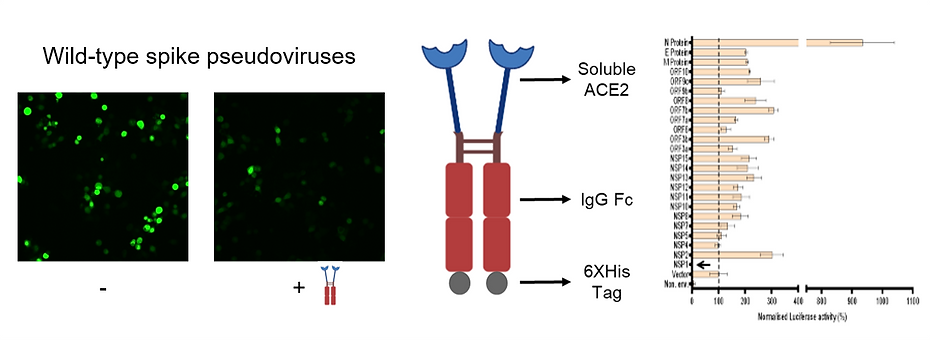Undergrad Research
I have enjoyed a diverse set of training experiences prior to my PhD at both IISER Bhopal and IISc. Here are some snapshots!
MS Thesis: An Fc-fused ACE2 microbody for neutralization of SARS CoV-2 spike-pseudotyped lentiviral particles

Supervisor: Dr. Ajit Chande, IISER Bhopal (2020-21)
I co-discovered an infection-enhancing functional role for the SARS CoV-2 nucleoprotein, as well as engineered a neutralizing microbody specifically targeted against the virus. Precisely, I developed a synthetic construct of the human angiotensin-converting enzyme 2 (ACE2) fused to the Fc domain of human IgG. ACE2 acts as the chief cellular entry receptor for SARS CoV-2, hence this construct acts as a neutralizing agent against lentiviral particles pseudotyped with the viral spike glycoprotein. I also undertook biochemical characterization and functional validation of the molecule using Western blotting, epitope tag-based pulldown, and second-generation lentiviral systems pseudotyped with both the wild-type SARS CoV-2 spike protein as well as its highly infectious D614G variant.
-
Tarun Mishra*, Sreepadmanabh M*, Pavitra Ramdas, Amit K Sahu, Atul Kumar, and Ajit Chande (* = equal contribution) - SARS-CoV2 nucleoprotein enhances the infectivity of lentiviral spike particles; Frontiers in Cellular and Infection Microbiology (2021)
-
Aditi Choudhary, Pratibha Madbhagat, Sreepadmanabh M, Vipin Bhardwaj, and Ajit Chande - Circular RNA as an additional player in the conflicts between host and virus; Frontiers in Immunology (2021)
-
Amit K. Sahu, Sreepadmanabh M, Mahendra K Rai, and Ajit Chande - SARS-CoV-2: Phylogenetic origins, pathogenesis, modes of transmission, and the potential role of nanotechnology; VirusDisease (2021)
-
Sreepadmanabh M, Amit K. Sahu, and Ajit Chande - COVID-19: Advances in diagnostic tools, treatment strategies, and vaccine development; Journal of Biosciences (2020)
iGEM Competition 2019

Supervisor: Dr. Apurba Lal Koner, IISER Bhopal (2019-20)
Our team developed novel strains of cold-tolerant chassis for recombinant protein expression. Cold tolerance-conferring genes like the Cpn 10/60 chaperones from O. antarctica and the co-chaperone Trigger Factor from P. haloplanktis were cloned into E. coli. We further coupled the experimental approach with a mathematical modeling-based analysis, which was also supplemented by extensive public engagement and industrial outreach initiatives in order to develop a holistic and comprehensive project profile.
Modeling Ovarian Cancer Metastasis and Spheroid Morphology using in-vitro Microfluidic Systems

Supervisors: Dr. Ramray Bhat and Dr. Bhushan Toley, IISc. (2018-20)
We analyzed multi-cellular collectives of ovarian cancer cells (spheroids) across fluid shear stress (FSS) gradients, using a PDMS-based microfluidic chip that aims to mimic the heterogeneous folds and curvatures of the peritoneal cavity. Comparative studies between single cells and spheroids in response to a range of FSS conditions were carried out, and the cellular viability was quantified as a function of the flow dynamics. Our observations implicate spheroidal morphology as a key factor determining the outcomes of exposure to FSS.
-
Sreepadmanabh M and Bhushan J. Toley - Investigations into the Cancer Stem Cell Niche using In-Vitro 3-D Tumor Models and Microfluidics; Biotechnology Advances (2018)